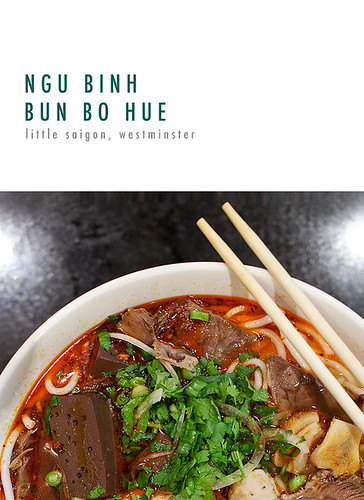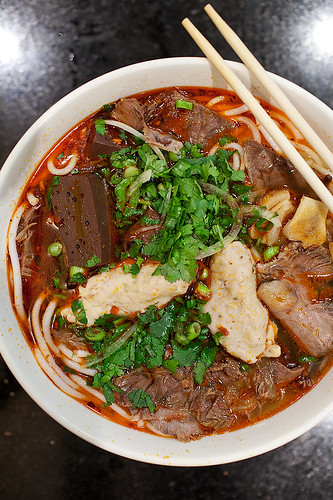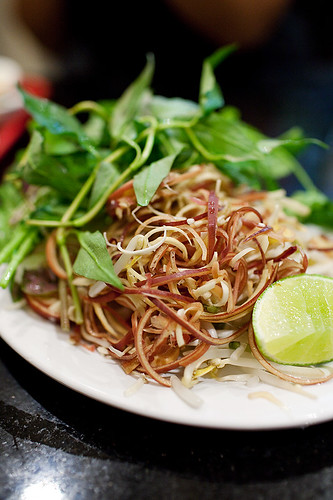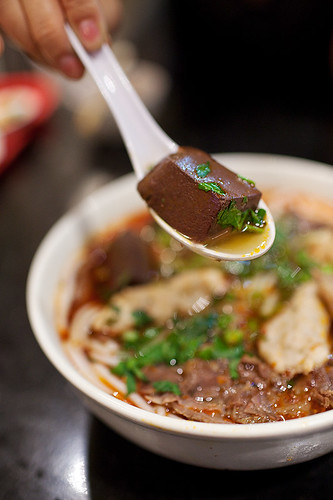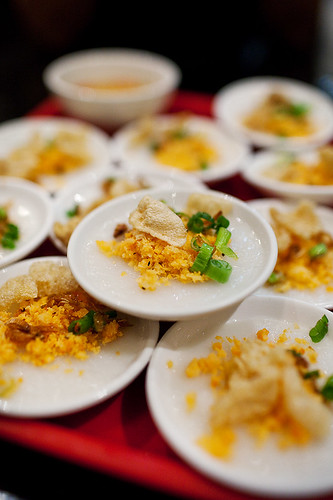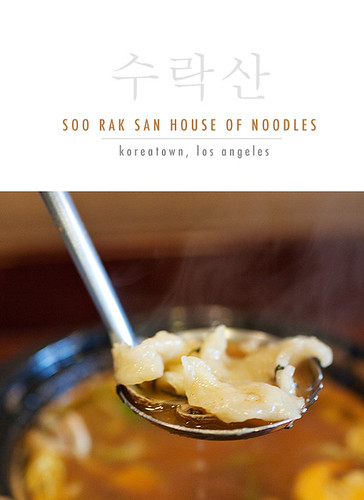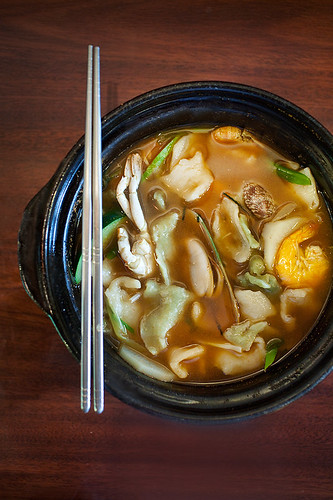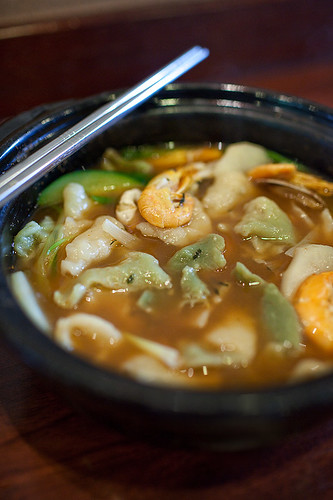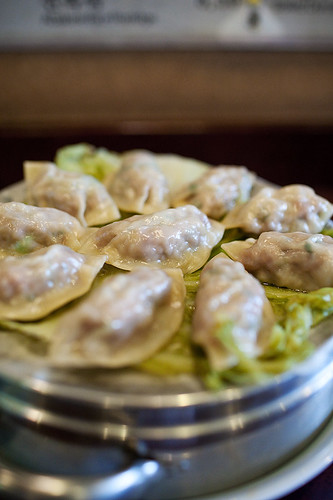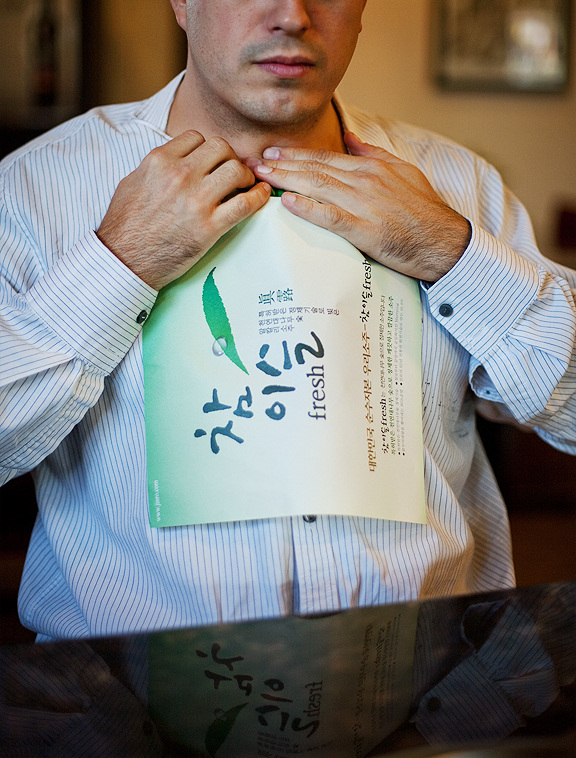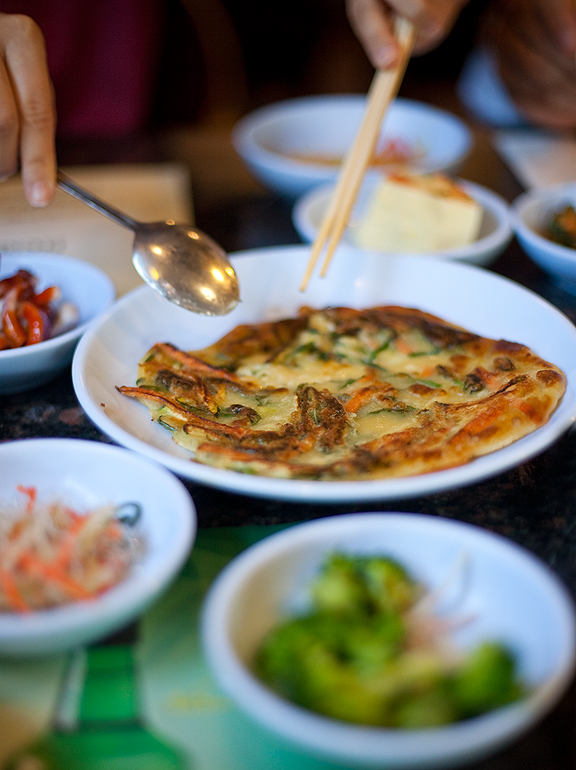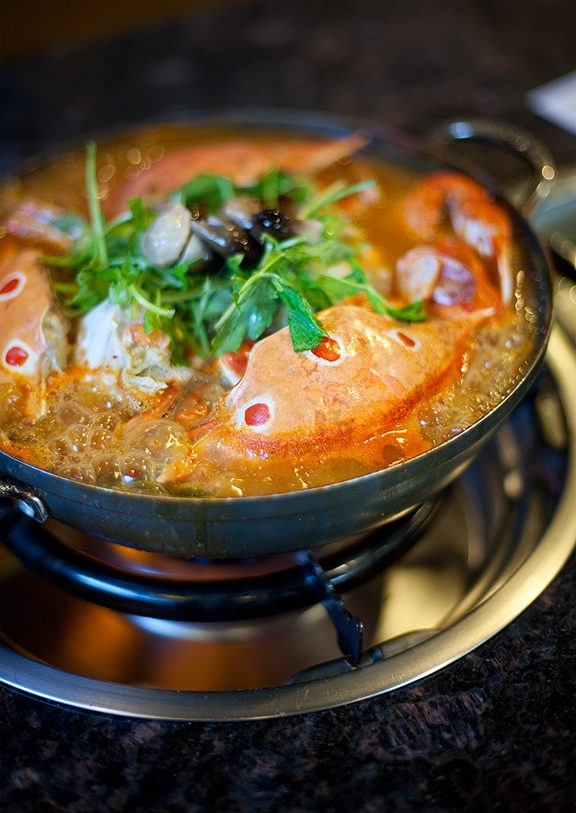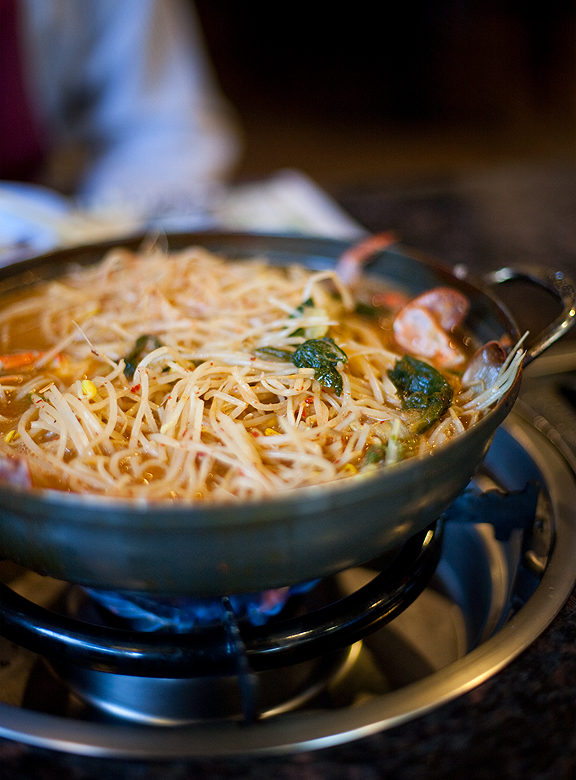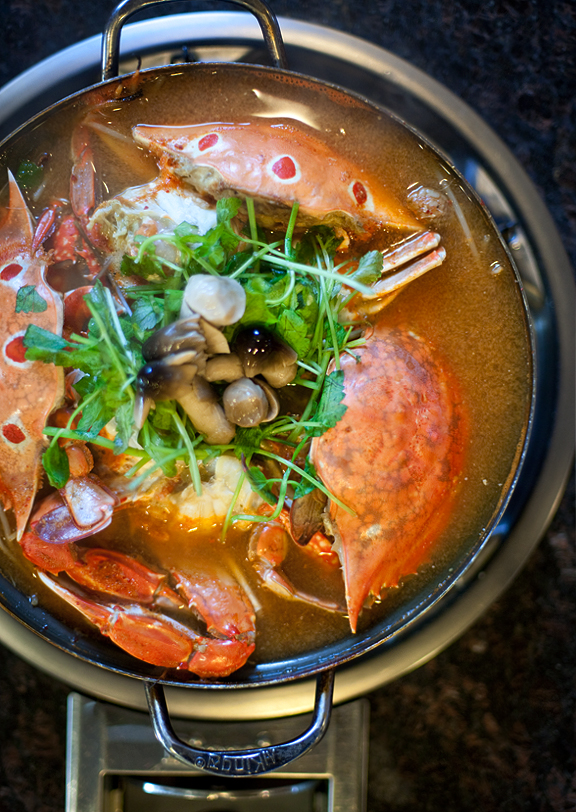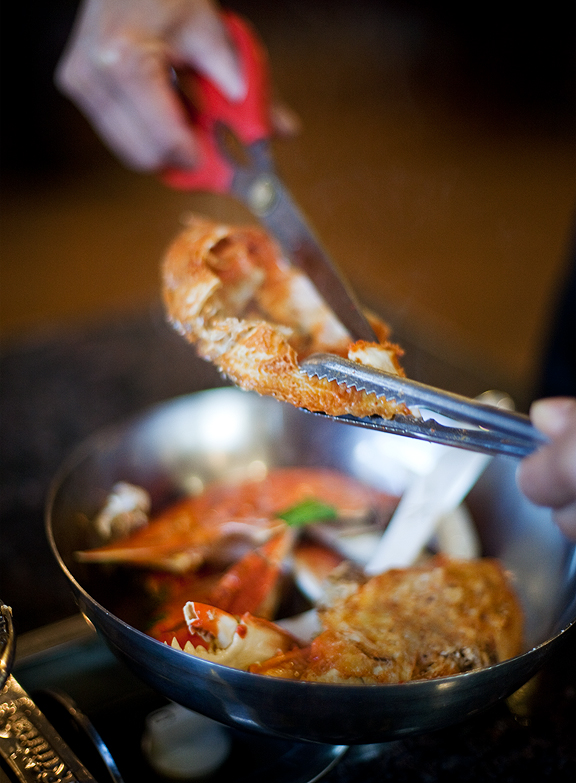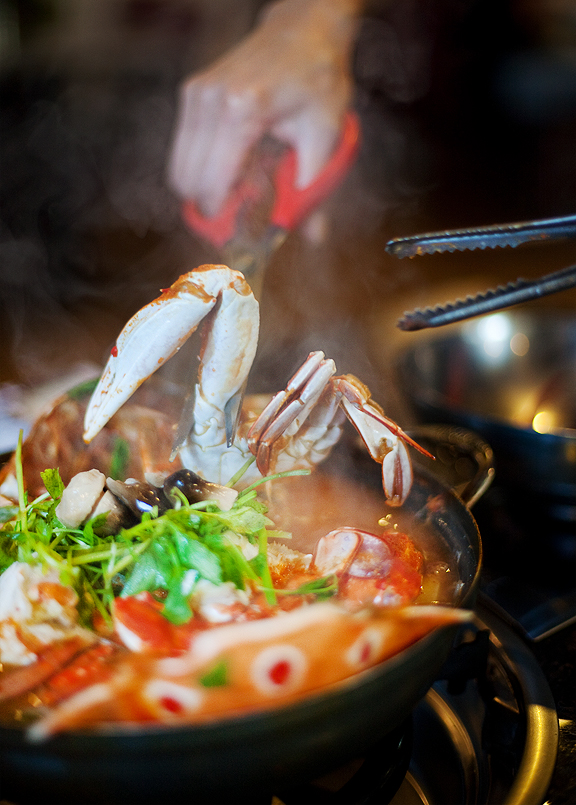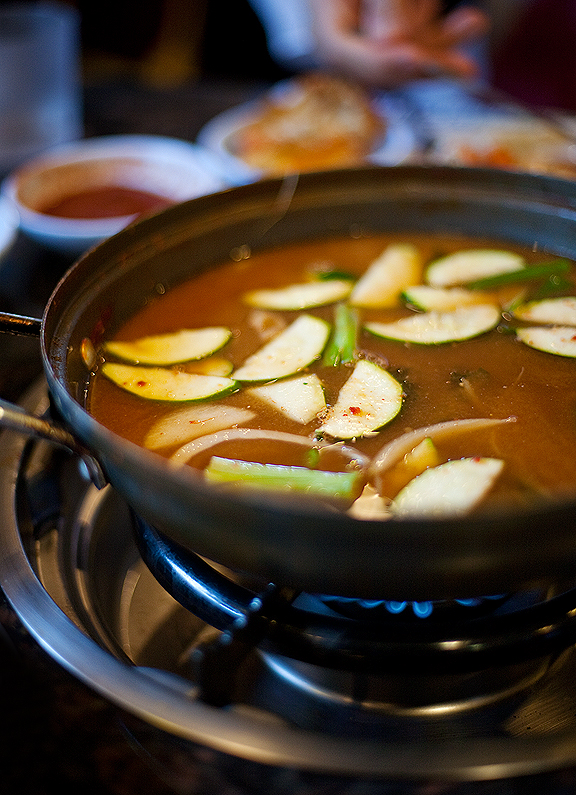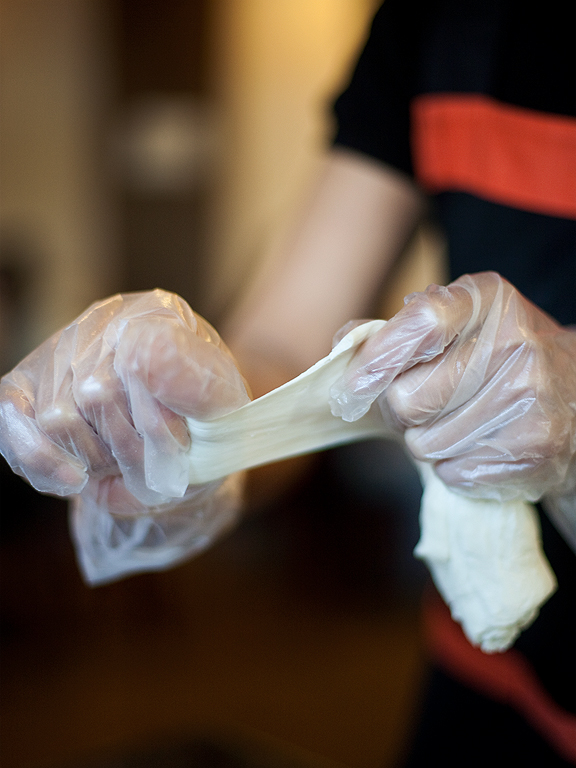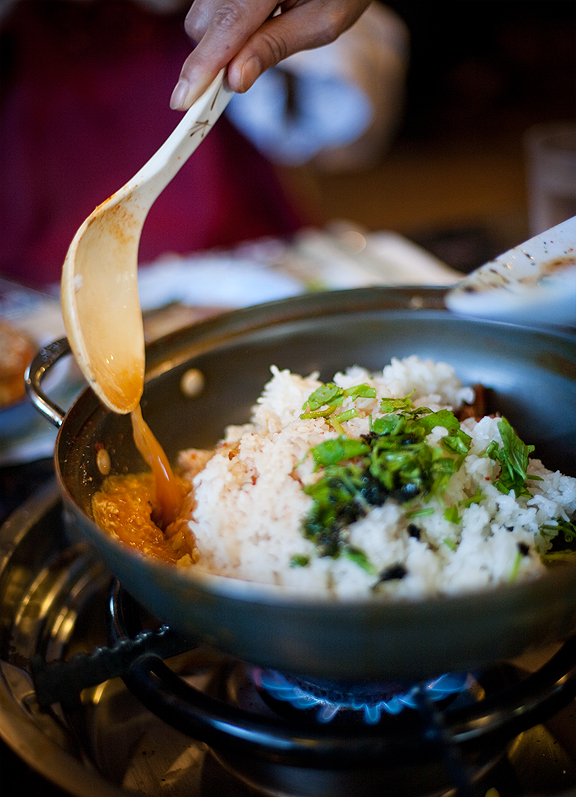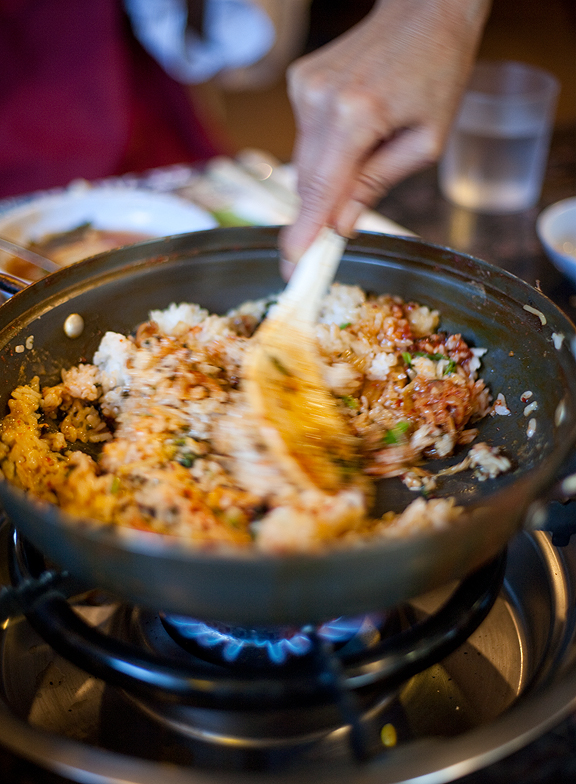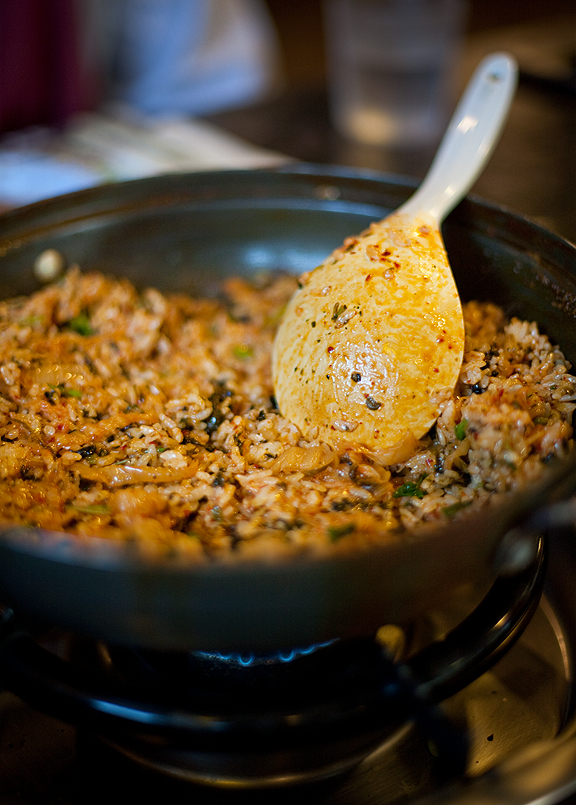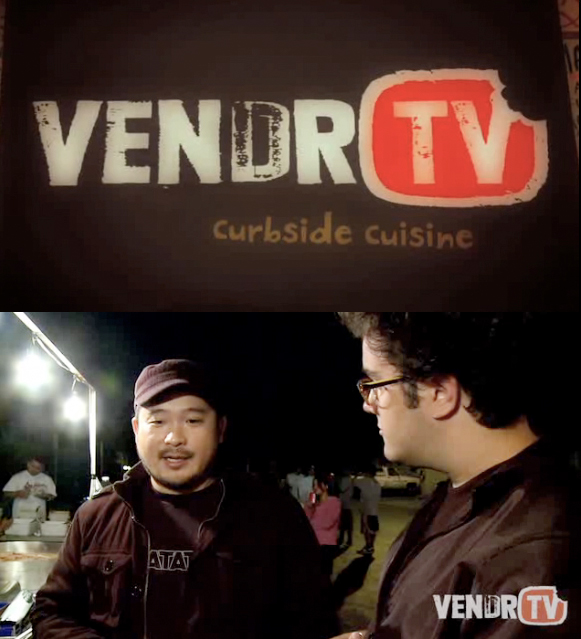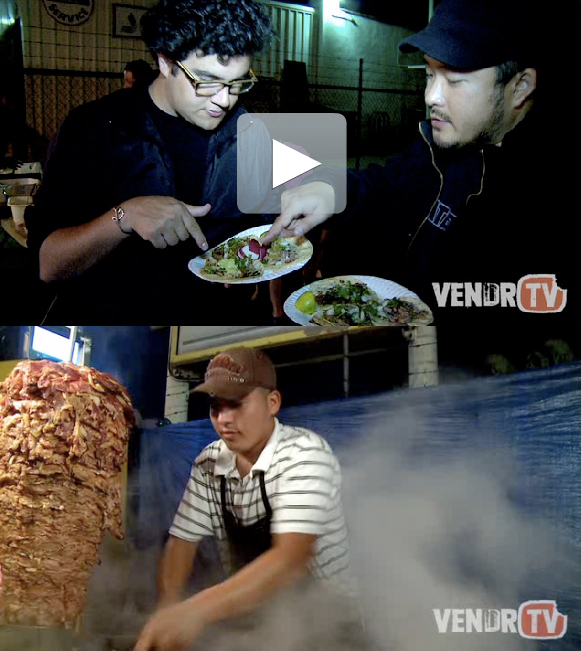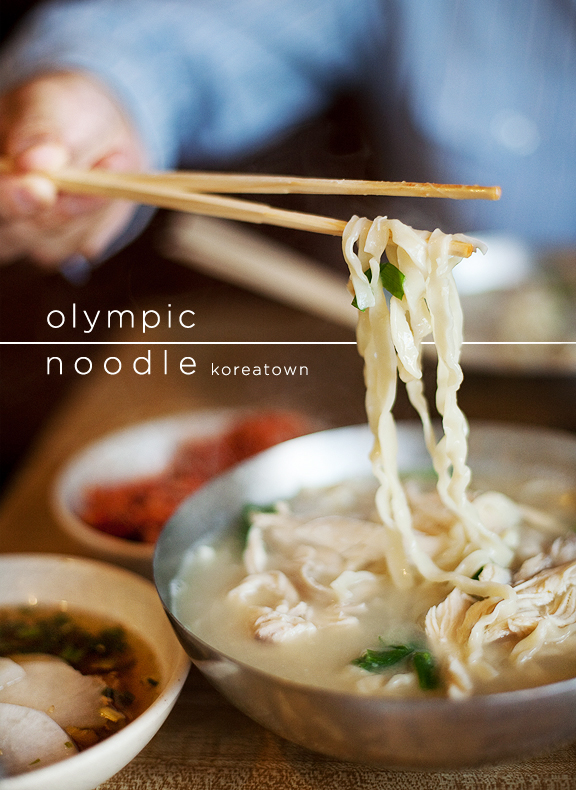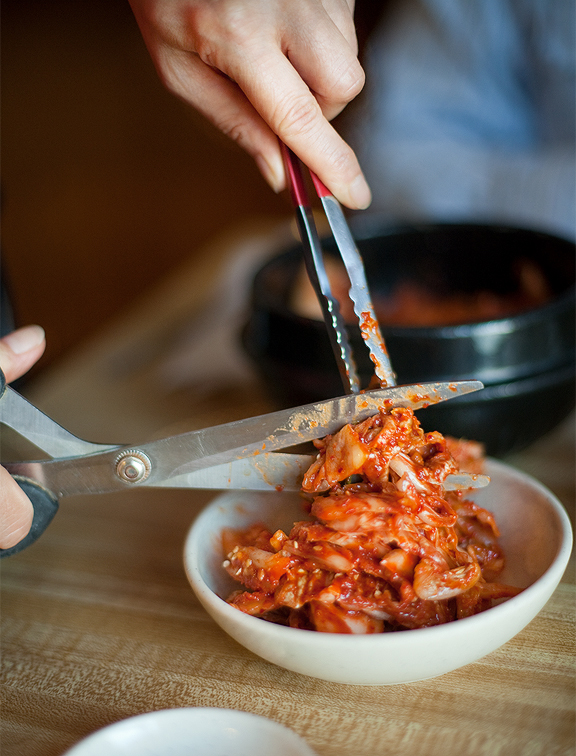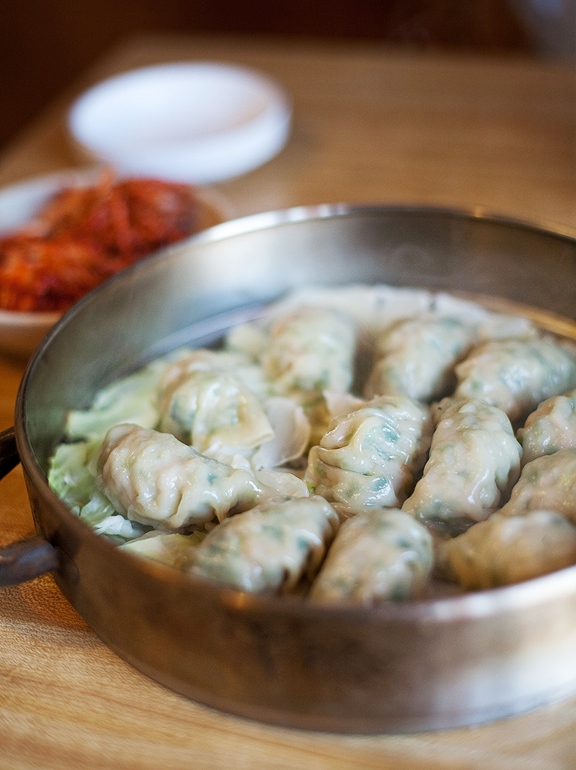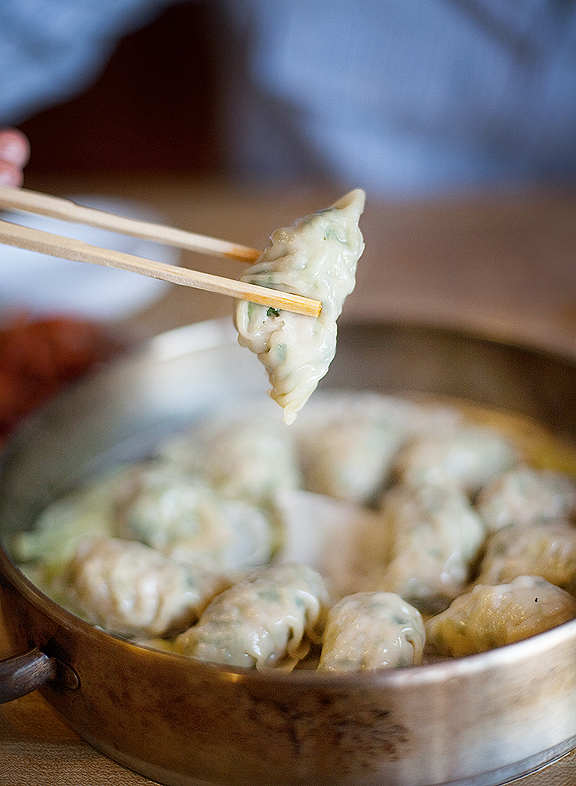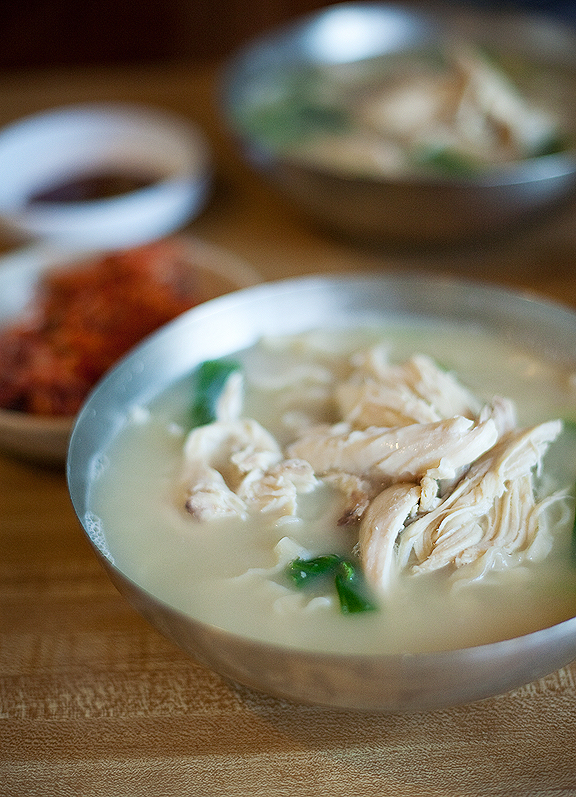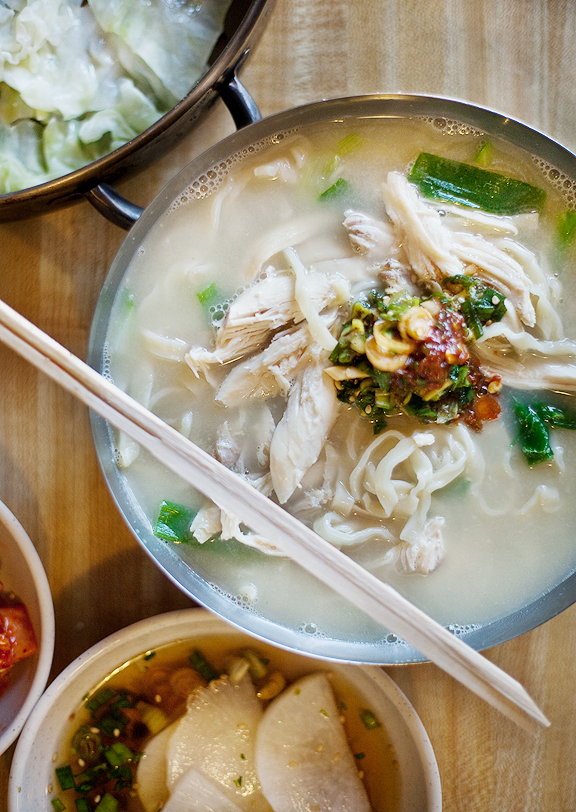When it comes to Vietnamese food, you can bet the first thing people will talk about is pho, a delicate soup noodle dish made from long hours of boiling beef bones, browned onions, fish sauce and various spices. Do not pronounce it like "foe" – all of your wrongdoings in life will be spilled over WikiLeaks and you'll be left to eat Costco samples for the rest of your life. I love pho as much as everyone does and enjoy eating it in whatever mood I'm in, but let's be honest, it's time it got off the stage like Leno. Of the hundreds of Vietnamese soup noodle dishes, it doesn't do much to the senses. There's definitely aroma, flavor and heat, but it is also one big bowl of boring. Zzzzz.
Believe it or not, pho will never go away. It's impossible. It's provided sustenance for Vietnamese people for decades and it fuels poor, starving college kids all over the U.S. It will not suddenly disappear off the face of this planet. As a suggestion for your New Year's resolution, may I suggest you start to veer off and try things like:
Banh Canh Cua - a thick, crab-based noodle soup with various seafood and meats
Bun Moc - a simple vermicelli soup with hand-made pork balls stuffed with wood-ear shrooms
Bun Rieu Oc - a dill & tomato flavored soup with snails or sometimes tofu & fishcake patties
Bun Thang - a soup noodle dish with thinly sliced fried eggs and Vietnamese meatloaf
Hu Tieu Nam Vang - an ode to Cambodian/Trieu Chau soup noodles also with various meats
Mi Quang - yellow rice noodles topped with shrimp, pork, peanuts and a side of broth
I can go on all day long about the various soup noodle dishes. When I was in Vietnam, they were everywhere. Cooked in restaurants, cafes, night markets and street stands. Each of the three main regions in Vietnam offer something delicious.
But the one soup noodle dish that I can never get enough of comes from the Central region of Vietnam known as Hue – bun bo hue. Literally it means "noodles", "beef" and "from Hue". The soup is made with beef bones, lemongrass stalks, ginger/onions/garlic and the key ingredient, chili oil. The result is a flavorful, fiery bowl of pure attitude. Look at it, it is the exact opposite of pho, it needs to attend anger management classes. My analogy: pho is the good catholic schoolgirl that never talks to boys, bun bo hue is the cigarette smoking, tatted-up bad girl destined to make a salary collecting $1 bills. Yes, raunchy but GOOD.
I'm sent to a place called Ngu Binh in Little Saigon by my friends MK and MT. It was about half-filled at 6 pm and in less than 10 minutes, J & I turned around to see at least 15 people waiting by the door for a table. I had also heard that the chef/owner of the restaurant is the only person with the responsibility of constructing each bowl of bun bo hue – no one else is allowed to. In English, that's called a "noodle Nazi" and its best to be out of the tornado's path. And on weekends, this place does sell out of bun bo hue. But on this day we were lucky.
In a few minutes, our desired bowl of bun bo hue arrives and it is filled with all sorts of goodies. This is peasant food at its best. You've got slices of tender beef shank, a nice piece of skin-on pork foot, nuggets of Vietnamese meatloaf called cha and pork blood cubes. NO, thank god there is no tai rare steak! At many places I've eaten bun bo hue, the broth sometimes can have too much lemongrass or too much rock sugar. The soup here is delicious and very balanced. The chef leaves you with no choice but to handle the chili oil, and it is awesome. The vermicelli noodles used are thicker than pho, and a common noodle used in Chinese soup noodles – typically in Yunnan and Southern China.
Here's the Google Earth view of the bun bo hue soup noodles. Amazing technology by Google. How funny would it be if you can zoom in on a restaurant. As you can see, there are a lot of things going on and its what makes this dish to me, quite a unique one.
But what I love most about Vietnamese food is the customizing that you're encouraged to do. How many of you like to alter the color of your pho from a boring color to something orange from Sriracha sauce or dark brown from the Hoisin sauce? Or do you like to overflood the bowl with huge handfuls of bean sprouts? With bun bo hue, the party doesn't stop. Here's a tip for you to spot out an authentic bun bo hue restaurant. If you are served purple cabbage versus banana blossoms pictured above, you aren't getting the real deal. Banana blossoms don't have a strong taste but texture-wise, they add a nice touch to the soup noodles. I recommend adding a ton of torn mint to this dish – it takes it to another level.
Pork blood cubes, aka, Chinese Chocolate. Love it or hate it, but don't dismiss the whole dish because of it. Made from congealed pork blood, this add another interesting texture that I really enjoy. The Chinese, Thai, Filipinos and Koreans also use this quite a lot in their cooking. Instead of freaking out, you can simply take it out. It's that easy.

Another thing that separates this place from other bun bo hue restaurants is in the way they serve the Vietnamese meatloaf known as cha. I've noticed that the Chinese/Trieu Chau-run Vietnamese restaurants will use thin slices cut from a larger loaf – usually 3-4 slices. Cheap! 100% Vietnamese-run restaurants will usually offer nuggets or "logs" of cha. What in the world did I just mean by that? There are Chinese EVERYWHERE. The ones that have migrated to Vietnam to work are usually of Trieu Chau (Chiu Chow) descent. Although they do speak Vietnamese, the are in fact, more in touch with the Chinese side. If you've been to Hanoi, you can definitely notice Chinese influence since it borders China. When I had it at the famed lunch lady Bourdain visited in Saigon, she offered HUGE pieces of cha in her bowl of bun bo hue. Her bun bo hue was definitely on the punchy, lemon-grass heavy side as opposed to Ngu Binh's. Anyway, the cha here is the best I have eaten in the U.S. I tried to buy some to go but I got denied because they wouldn't have enough to complete their orders.
At a Hue restaurant, you will hardly find egg rolls. But that's okay. Instead, you will see a lot of delicious rice-flour based dishes such as this, banh beo, steamed rice cakes topped with ground shrimp, fried shallots, scallions and my favorite, fried pork skins (chicharrones). Here at Ngu Binh, they certainly don't skimp on the toppings but the rice cake itself is a bit too thick. I actually prefer the thinner, translucent ones found at Quan Hy and Quan Hop.
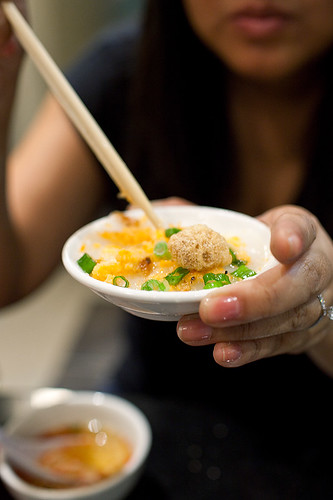
Thanks again to MK and MT for the suggestion. A lot of versions I've tried either have too much MSG, too much sugar, too much fish sauce or simply lose their flavor at first sip. Ngu Binh is easily my favorite bun bo hue at the moment. Yet another stop in the wonderful Vietnamese food court known as Little Saigon.
Here are some other bun bo hue places I've tried/heard about:
Bun Bo Hue So 1, Westminster, CA
I used to frequent this place but the taste went down over the years. Very punchy lemongrass flavor. I like the mi quang here though.
My Linh's Bun Bo Hue, Garden Grove, CA
A friend told me about this place but I have yet to try it.
Pho Cong Ly Saigon Deli Restaurant, Garden Grove, CA
Another place I hear a lot about. Anyone try?
Brodard, Garden Grove, CA
The mecca for charbroiled pork rolls (nem nuong) offers a plethora of Hue food and is always packed. I've had several dishes here and they all seem average to me, including the bun bo hue.
Kim Hoa Hue, South El Monte, CA
A very balanced bun bo hue is offered here in what I refer to as Mini Saigon – all on Garvey Avenue. I love ordering the banana-wrapped goodies like nem chua, aka Vietnamese Roulette due to its "raw-but-cooked" look and cha hue. If you don't want to drive far, this will do you just fine.
Nem Nuong Khanh Hoa, Rosemead, CA
Run by a very nice Chinese/Trieu Chau (see I told you they exist!) family for a few years, they offer good nem nuong rolls but unfortunately I think the bun bo hue itself can use a little work. All I remember from is being very thirsty from the MSG used.
Nem Nuong Ninh Hoa, Rosemead, CA
This place has been here since the 90s, maybe even earlier, and located next to In & Out and Rosemead High School. Very punchy, lemongrass flavor. Sometimes a bit heavy on MSG. I recommend their nem nuong platter for an appetizer.
Mien Trung, Rosemead, CA
Run by a nice family, they offer various Hue dishes. It's not bad but there's a quick flavor fallout. I'd give their other dishes a try though. I would rather continue driving east to Kim Hoa Hue in Mini Saigon.
Nha Trang, San Gabriel, CA
This is a new spot run by a Chinese/Trieu Chau (ahem!) lady. She runs out of her Hue-style food pretty much on the weekends so you'll have to go here earlier in the day. Unfortunately, I came on a day they were sold out.
M Delivery, San Gabriel, CA
I had high hopes in this place that now takes over the old Banh Mi shop next to Popeye's. The place was screaming bun bo hue but unfortunately, it was less than average and strong on MSG. They do a lot of take-out/catering orders here.
Thanks for reading. Give bun bo hue a chance and hopefully you'll understand why I crave it so often.
Here are some other bun bo hue places I've tried/heard about:
Bun Bo Hue So 1, Westminster, CA
I used to frequent this place but the taste went down over the years. Very punchy lemongrass flavor. I like the mi quang here though.
My Linh's Bun Bo Hue, Garden Grove, CA
A friend told me about this place but I have yet to try it.
Pho Cong Ly Saigon Deli Restaurant, Garden Grove, CA
Another place I hear a lot about. Anyone try?
Brodard, Garden Grove, CA
The mecca for charbroiled pork rolls (nem nuong) offers a plethora of Hue food and is always packed. I've had several dishes here and they all seem average to me, including the bun bo hue.
Kim Hoa Hue, South El Monte, CA
A very balanced bun bo hue is offered here in what I refer to as Mini Saigon – all on Garvey Avenue. I love ordering the banana-wrapped goodies like nem chua, aka Vietnamese Roulette due to its "raw-but-cooked" look and cha hue. If you don't want to drive far, this will do you just fine.
Nem Nuong Khanh Hoa, Rosemead, CA
Run by a very nice Chinese/Trieu Chau (see I told you they exist!) family for a few years, they offer good nem nuong rolls but unfortunately I think the bun bo hue itself can use a little work. All I remember from is being very thirsty from the MSG used.
Nem Nuong Ninh Hoa, Rosemead, CA
This place has been here since the 90s, maybe even earlier, and located next to In & Out and Rosemead High School. Very punchy, lemongrass flavor. Sometimes a bit heavy on MSG. I recommend their nem nuong platter for an appetizer.
Mien Trung, Rosemead, CA
Run by a nice family, they offer various Hue dishes. It's not bad but there's a quick flavor fallout. I'd give their other dishes a try though. I would rather continue driving east to Kim Hoa Hue in Mini Saigon.
Nha Trang, San Gabriel, CA
This is a new spot run by a Chinese/Trieu Chau (ahem!) lady. She runs out of her Hue-style food pretty much on the weekends so you'll have to go here earlier in the day. Unfortunately, I came on a day they were sold out.
M Delivery, San Gabriel, CA
I had high hopes in this place that now takes over the old Banh Mi shop next to Popeye's. The place was screaming bun bo hue but unfortunately, it was less than average and strong on MSG. They do a lot of take-out/catering orders here.
Thanks for reading. Give bun bo hue a chance and hopefully you'll understand why I crave it so often.
